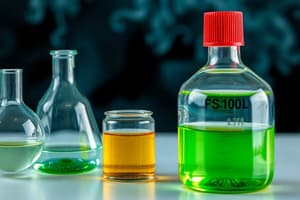Podcast
Questions and Answers
What does the law of mass conservation state?
What does the law of mass conservation state?
- The mass of an element does not change during a reaction.
- The mass of reactants can vary in chemical reactions.
- The mass of products is always greater than the mass of reactants.
- The mass of reactants equals the mass of products. (correct)
The ratio of elements in a compound remains constant according to the constant composition law.
The ratio of elements in a compound remains constant according to the constant composition law.
True (A)
What is Avogadro's number?
What is Avogadro's number?
6.023 × 10^23
The formula for calculating ______ of gases is 𝜌(𝑔/𝑐𝑚³) = 𝑚(𝑔) / 𝑣(𝑐𝑚³).
The formula for calculating ______ of gases is 𝜌(𝑔/𝑐𝑚³) = 𝑚(𝑔) / 𝑣(𝑐𝑚³).
Match the following concepts with their definitions:
Match the following concepts with their definitions:
Which of these formulas denotes the mass of an element in a compound?
Which of these formulas denotes the mass of an element in a compound?
The equivalent mass of an element can be directly calculated by dividing its atomic mass by its molar mass.
The equivalent mass of an element can be directly calculated by dividing its atomic mass by its molar mass.
If a compound has a mass of 100 grams and the mass of an element in it is 25 grams, what is the mass percentage of that element?
If a compound has a mass of 100 grams and the mass of an element in it is 25 grams, what is the mass percentage of that element?
The formula for calculating the number of moles is n(mol) = _______.
The formula for calculating the number of moles is n(mol) = _______.
Flashcards are hidden until you start studying
Study Notes
Definitions in Chemistry
- Law of Conservation of Mass: Matter remains unchanged; it cannot be created or destroyed.
- Law of Constant Composition: A compound's element composition is uniform across all samples.
- Law of Combining Gas Volumes: Gas volumes reacting or produced in a reaction are in simple numerical ratios, provided pressure and temperature are constant.
- Avogadro’s Hypothesis: Identical gas volumes at the same pressure and temperature contain an equal number of molecules.
- Valence: Indicates the number of electrons an element can lose, gain, or share in reactions.
- Atomic Mass Unit (amu): Defined by the mass of the C-12 isotope (12.0000); 1 amu is 1/12 of this mass.
- Equivalent Mass: Mass of an element that combines with or displaces eight mass parts of oxygen.
- Empirical Formula: Shows the simplest whole-number ratio of atoms in a compound.
- Molecular Formula: Represents the actual number of atoms in a molecule.
- Temperature Units: Measured in degrees Celsius (C˚), Kelvin (K), and Fahrenheit (F˚), indicating heat flow direction.
- Avogadro's Number: 6.023 × 10²³, representing the number of atoms in 1 mole or the number of molecules in 1 mole of a compound.
- Molar Mass: Mass of one mole of atoms or molecules expressed in grams.
Key Laws in Chemistry
- Law of Mass Conservation: Mass of reactants equals the mass of products in a reaction.
- Law of Constant Composition: Element ratios remain constant across compound samples.
- Atomic Mass: Relates to Avogadro's number (6.023 × 10²³) for calculating absolute mass.
- Equivalent Mass Relationship: Compares equivalent masses based on the same compound interactions.
- Atomic Mass, Equivalent Mass, and Valence: Atomic mass of an element equals its equivalent mass divided by the valence.
- Gas Density: Density (ρ in g/cm³) calculated as mass (g) divided by volume (cm³).
- Mole Concept:
- Number of moles (n in mol) equals mass (g) divided by molar mass (g/mol).
- Number of moles also relates to Avogadro's number.
- Mass Percentage:
- Calculated as (Mass of Element / Mass of Compound) × 100%.
- Mass of Element in a Compound: Determined by the ratio of the element's mass to the compound's total mass.
- Empirical Formula Ratio: Based on the mass or percentage of the element within the compound, establishing a foundational understanding of chemical formulas.
Studying That Suits You
Use AI to generate personalized quizzes and flashcards to suit your learning preferences.




